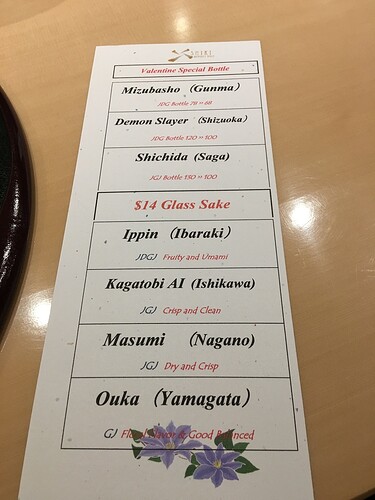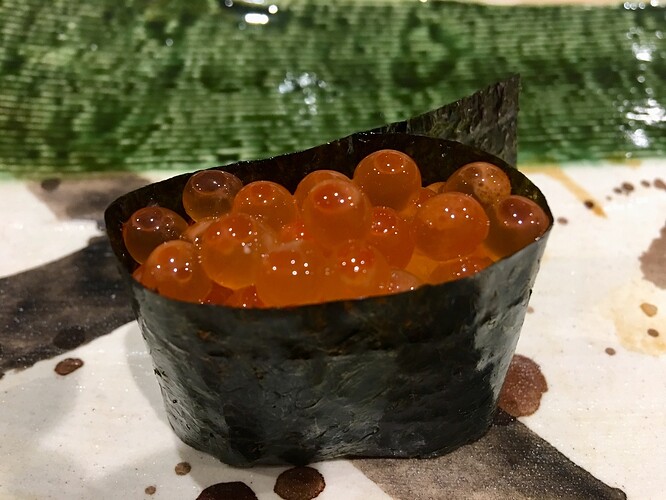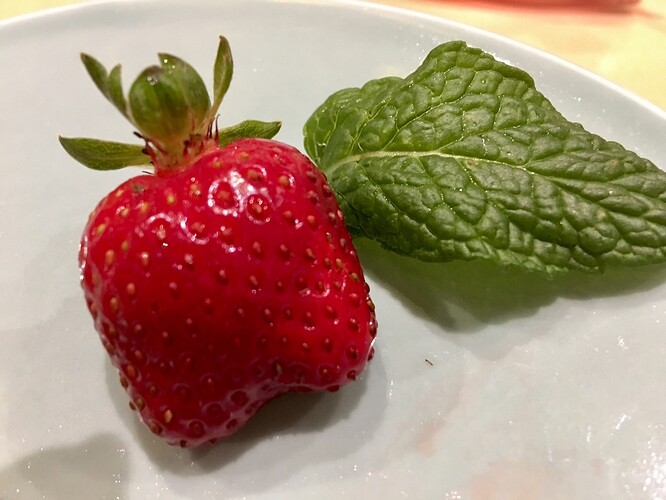He told me he’s there every day they’re open, for lunch and dinner, except for Wednesdays. I would call to double check but I can’t imagine why he wouldn’t do a lunch omakase for you.
I know it’s the thing to sit in front of Mori-san at Shiki right now (I did it myself). But if he’s not available for lunch, seriously consider young Chef Jun. You won’t regret it.
Shiki Beverly Hills
Valentines Day with Chef Morihiro Onodera & Co.
This was a surprise. We don’t usually celebrate Vday on Vday. I definitely didn’t expect this. We were having dinner at Il Postaio and my husband slipped into Shiki and came out with a reservation. Good choice - we had the counter and Mori-san to ourselves the whole evening. Another surprise? I’m doing a report on it. They definitely encourage it.
I didn’t note every detail. This was Valentines Day, not Sushi School. Plus we all got a little tipsy toward the end.
The Evening’s Sake Menu
…But we called ahead for this - ”Willow Tree”
Thanks @beefnoguy! The hostess, Mio, practically squealed when I called to request it. It’s her favorite. She calls it Lady Sake. It is lightly fruity with a surprisingly rich sweetness that permeates your whole mouth. My non-lady husband loved it. We took a sip, swirled, looked at each other and smiled. It’s on!
They didn’t break out the crystal, but this was a fine glass.

Mori-san apologized for only being able to serve the prix fixe Valentines Menu. He asked and we promised to come back for his Omakase.
I picked #1 and my sweetheart picked #3. They encouraged us to share and thoughtfully cut the Nigiri in half.
Sakizuke - 1st Appetizers:
House-made Tofu w/Marinated Cherry Blossom in a light Dashi
Jikasei Ankimo Tofu w/Ikura - House-made Monkfish Liver Tofu w/Salmon Roe
A burst of flavor in a delicious Dashi.
Zensai - 2nd Appetizer Course
@Chowseeker1999 perfectly described the flavors of the Wakamomo - Baby Mountain Peach Gelee. I can’t remember what the bite was on the top center, except it was yummy.
Otsukuri - Assorted Sashimi
I’m pretty sure the Tuna Belly was Chutoro (medium fatty). It was melt in your mouth goodness.
King Crab Sunomono (cucumber salad)
Vegetable Tempura w/Curried Dipping Salt
I
Yakimono - Marinated, Grilled Wagyu Beef
One was sirloin (beefy flavor, more chew) and the other was a tenderloin (tender, marbled deliciousness).
We shared our “Yanagi” with Mio and Chef. In return Mori-san shared his Nanbu Bijin.
This is a favorite of Mori-san’s, brewed where he is from in Northern Japan, It is clean and dry with a delicious floral punch. I must find it!
Gohan-Mono - Assorted Sushi Course:
Not Sure… Halibut or Squid?
Akami or Toro - Red Meat Tuna
Chutoro - Medium Fatty Tuna
Buri (possibly?) Adult Yellowtail
Sayori - Needlefish
Is Needlefish and Halfbeak the same? I’m pretty sure he said Needlefish.
Is that Geoduck or possibly Scallop? with Kinmedai - Splendid Alfonsino
Ikura - Salmon Roe
I’ve come to learn, all Ikura is not equal. These were fresh, briny & bursting with ocean flavor.
Uni - Sea Urchin (Santa Barbara)
Same goes for the Uni. Yep, I could have eaten three more.
Kohada! - Gizzard Shad
Okay, so, Chef Mori was apologetic but firm about no off-the-menu items on this night. That was until my husband yelled out Kohada! in a Kanpai! kinda’ way. Chef Mori gave us a big smile, walked away and came back with oily, vinegary, salty deliciousness.
I’m slowing starting to understand the Rice thing. Not so much the varietals(?) yet, but the polish. I might be imagining things, but I think the rice I had during my lunch with Chef Jun was better. The individual grains were more distinguishable.
Example:
Handroll from Chef Jun

Am I trippin’?
Blood Orange Gelee & Strawberries
I’d like to know where they found this little gem in February.
Fantastic Valentines Day!
Mori-san is super friendly. He & his bro, Nao-san, are a crack-up and clearly happy to be working together.
P.S. @Chowseeker1999 - I think you’re right. The back counter does seem to be repurposed for Chef Mori.
Great report!! Now you are on the path to “the road to delicious ruin”!
It’s too bad they stuck to a Valentine’s set menu, but it’s good to know. Probably something similar for Mother’s Day, New Year’s Eve maybe?
The markup for the V-day sake is almost x3 retail for not so exciting low to mid tier choices… not so great types by the glass also. Not the best choices for food pairing either.
Glad you got the Yanagi and enjoyed it! Definitely a far better choice than their V-day special selection sake. It’s an excellent bottle and one of my favorites out of the three exported! Tsukinokatsura brewery uses a sake rice called “Iwai” (meaning “celebration”) that is native to the Kyoto region and is very expensive/high cost. The plushy feel to the sake is also a result of them using natural soft ground water from the Fushimi area (Fushimi = Fushu + Mizu meaning ground water) famed for its purity, softness, and flavor profile, resulting in a brew that is more feminine in nature…but it does not mean it drinks light. It’s got a very nice finish and some almost cascading peppery notes on the way down. @Chowseeker1999 has had their Junmai Daiginjo (Heiankyo) with food at Shunji which also works with kaiseki cuisine, but this Yanagi has a more enjoyable profile for me at least, and is a bit more versatile with food pairing. Though I’m not sure it is a good with the grilled wagyu beef (which would need a sake that is bolder/full bodies, and more acidic…here’s where a proper warm or hot sake might work)
Thanks for posting Mori san’s drink. I remember seeing the Nanbu Bijin Daiginjo at the Torrance location of Marukai several years back, that’s not available in Northern California interestingly.
Mori Sushi I think stocks the plum sake (umeshu) by NB and it’s quite good. The brewery is located in Iwate Prefecture, and the President does his round via a world tour to promote his sake overseas (very hard worker I might add) and is quite a lively fellow. NB’s Tokubetsu Junmai won the IWC (International Wine Challenge) Champion sake in 2017 and is worth trying (I recently paired a glass with ramen from Ippudo and it was surprisingly decent and easy to drink!)
Uh, someone here is nearing graduation from Sushi School !
Hi @TheCookie,
Woo! Sounds like you had a wonderful Valentine’s Day with one of L.A.'s best sushi masters. ![]() The meal looks great even if it was “only” a prix fixe menu. Mori-san is just such an affable, nice itamae right?
The meal looks great even if it was “only” a prix fixe menu. Mori-san is just such an affable, nice itamae right? ![]()
I will definitely have to try the Yanagi Sake next time, and so glad you loved the Japanese Mountain Peach bite (I still think about it from time to time!). ![]()
And I’m so glad you got to try the Kohada, it’s really distinct and he prepares in a Jiro (“Jiro Dreams of Sushi”) method that he learned from the master. The bite next to the Kinmedai should be a type of Ika (Squid).
Great job on the report and thoughts.
Hi @beefnoguy,
Ooh! The Yanagi is from the same brewer as Heiankyo? Nice! ![]() We really enjoyed the Heiankyo Junmai Daigjinjo last time.
We really enjoyed the Heiankyo Junmai Daigjinjo last time. ![]()
Sounds like a great meal. The ankimo tofu looks wonderful. PSA @TheCookie Torigai is in season, I think I prefer this over mirugai, very sweet
Hi @beefnoguy -
We had to read this a few times. The knowledge flows with ease. Thanks, I was hoping you would add to my description. This was the first bottle that blew our minds. Yep… we’re on the road to delicious ruin.
Yes, Nanbu Bijin Daiginjo doesn’t seem easy to find without mail order. My cousin goes to Marukai. I’ve given her the task. We had a bottle of Plum Sake (Umeshu) in the fridge for a while. It was cooking wine quality. The liquid and plums (minced) are good in vinaigrette and marinades.
Still learning what qualities are good for sake/food pairing. Is there a general rule?
Well, high praise indeed.
There are more sake out there that could potentially have similar mind blowing effects!
What qualities are good for sake/food pairing? Great question and glad you asked.
There are no hard or fast rules for pairing sake with food (or vice versa). Overall, the more polished the rice in the sake, the lighter the flavor profile for food (e.g. Junmai Daiginjo sake generally would be better paired with white fleshed fish sashimi, raw oysters, lighter flavor / more delicate profile sushi, uni, sweet pristine shellfish, lobster etc). Otherwise you end up overwhelming the sake or there is lesser effect with pairing. Think of your types of white wine or lighter/medium bodied reds as a distant parallel as to what kind of food you would pair them with, including Japanese.
Lower polished sake like Honjozo and Junmai are more fuller bodied and have more flexibility with food in general, and can withstand some heating (e.g. warm sake) where if the right type is used with the proper heating technique, can produce wonderful results with certain food…contrary to popular belief, warm/hot sake is actually great with oily/greasy foods, including tempura. Certain traditionally made sake have far more structure and increased, yet balanced acidity…these can be far more bolder than casual drinkers can handle (including a profile some would deem “funk”)…e.g. sake made with Kimoto or Yamahai method where both involve the creation of lactic acid for fermentation naturally (thus taking twice as long as non traditional methods where starter yeast is added to speed up the fermentation process). The Kimoto method includes a step of using large fan like paddles to press and stir the mash (though some Kimoto are apparently “fake” Kimoto using machinery for stirring/pressing instead of by hand). The acidity and sometimes tartness associated with the traditional methods can be really enjoyable with particular foods designed to go with sake, including strong cheese that work great with Pinot Noir (e.g. Epoisse, Comte, sheep milk based cheese, or goat or blue), but also typical “otsumami” or snack bites to go with sake (e.g. shiokara/fermented squid in its own bile, takowasa (chopped octopus marinated in wasabi), konowata (pickled sea cucumber guts), and last but not least shuto (salted/fermented fish based guts, most typical are katsuo and maguro) which go great with cream cheese. Of course anything oily greasy could use some full bodied sake with acidity to clean it up/wash it down…yakitori or charcoal grilled anything comes to mind.
Junmai Ginjo have polish ratios between 50% to 60/70%, sometimes the line gets blurred…since by some definitions Junmai Daiginjo have a minimum polish ratio of 50%, but you also have Junmai Ginjo, Ginjo sake polished to 50% but are not labled as Junmai Daiginjo.
Sometimes you can get a vague idea of a sake’s profile once you have tasted enough, from taking a look at the specs. The polish ratio only matters to a certain degree…then you want to look at whether it is a dry/semi dry sake etc, and any characteristics/descriptions (you’d probably have to learn Japanese or kanji for this)…for example Mori’s bottle says “Houjun” on the Daiginjo label which roughly translates to mellow, but with it there’s some sort of dynamic/reference to aromatic but perhaps with some subtlety. There are sake with other characteristics such as karakuchi (leaning more dry), umakuchi (more umami in the profile), amakuchi (more fruit forward not just in the nose and initial attack) and unfortunately these tend to be on the Japanese label (sometimes distributors are lazy or they don’t translate all the information correctly). Then finally acidity and alcohol percentage, and any tasting notes from the distributor, vendor…and if you are super geeked out, tasting notes from Japanese websites for more accurate information to paint a bigger picture. And oh, last but not least, the prefecture of the sake brewery. If you taste enough sake from Niigata and Ishikawa (for example) you will know those have certain profiles that are different from sake from the west (Kobe/Hyogo, Kyoto, Hiroshima), and of course water from various regions that sometimes makes or breaks whether the sake is masculine or femine (e.g. more minerality vs softness via softwater). Super geeks will also try to find out the type of sake yeast used in the brewing process. Ultimately until you taste it, you won’t know if you will like it or not, but it helps to have a baseline knowledge, or have this in mind when you want to come up with your own optimal pairing scenario.
Bottom line, much like wine, it’s better to do as much actual tasting as you can and explore for yourself to come to your own determinations and preferences. Unfortunately sake tasting opportunities are too far and few in between, so actual hands on learning will require investing money, time, and patience, unlike with wine you can find wine shops that offer some tastings. Or if a restaurant offers sake pairing, give it a go. Or ask for recommendations from restaurants that are trustworthy and have a healthy turnover of stock (and seasonally rotates their sake menu). I encourage you (and others) to pick out some selections you feel comfortable with and try enjoying them at home with a variety of food, from American to Western to things like BBQ or non Japanese cuisines, pizza, pasta, taco trucks or fusion tacos, anything non Japanese really. Ultimately the best tasting grounds at least for me tend to be at izakaya where I trust that the food will work great, or even experiment with places like no corkage pop up eateries. Go have fun with it.
Thanks @Chowseeker1999!
We talked about the board and how excited peeps are that he’s back and working again.
Happy ![]() Eating!
Eating!
yes the bottom right looks like mirugai. was it sweet and crunchy?
Yes and yes
bottom left looks like kanpachi
Spring is generally the season for clams. Torigai is great, and beautiful, too. Mirugai is a favorite of mine, one of my top 5. Tairagai (“pen shell clam”) is scallop-esque, and is great with a little nori wrap (maybe as “tairagai no isobeyaki” to look like a mochi sandwiched in nori), Consider also baigai (“ivory shell”) aka sea snails, which are great when cooked “nibitashi” (braised in a sweet dashi-based broth) and eaten with a toothpick. They have a great chewy texture that is nice alongside hotaru ika (another Spring specialty) with su-miso sauce and some contrasting thin cucumbers.
I think these can even go well with some mild game or grilled meats. Consider maybe a grilled lamb chop kojizuke or even kalbi. They might even work slightly warmed if there’s some type of barbecue sauce.
Okay good. I knew the general area. But figuring out Amberjack, Yellowtail, Kampachi, Kanpachi, Japanese Amberjack is still like “Who’s on First?” for me. It’s a bummer because we recently went to Aburiya Raku (again ![]() ) and had the Sashimi Sampler (again
) and had the Sashimi Sampler (again ![]() ), and they were excited to offer a not easily found species of one-of-the-above, but I couldn’t report on it because I’m confused and am loathe to repeadly ask the server to repeat his/herself.
), and they were excited to offer a not easily found species of one-of-the-above, but I couldn’t report on it because I’m confused and am loathe to repeadly ask the server to repeat his/herself.
Bottom right. Anyone?
looks like kan-buri - winter yellowtail

























